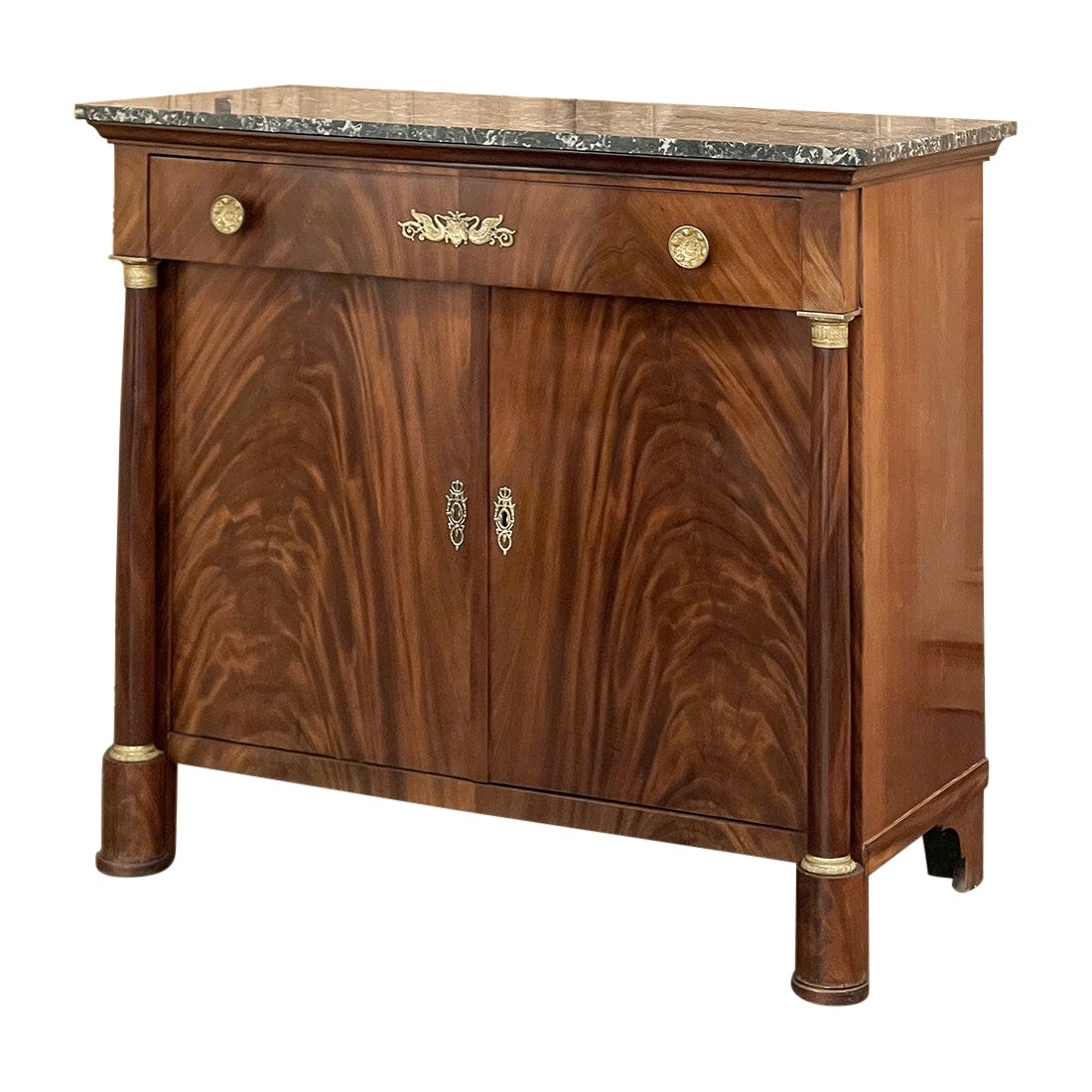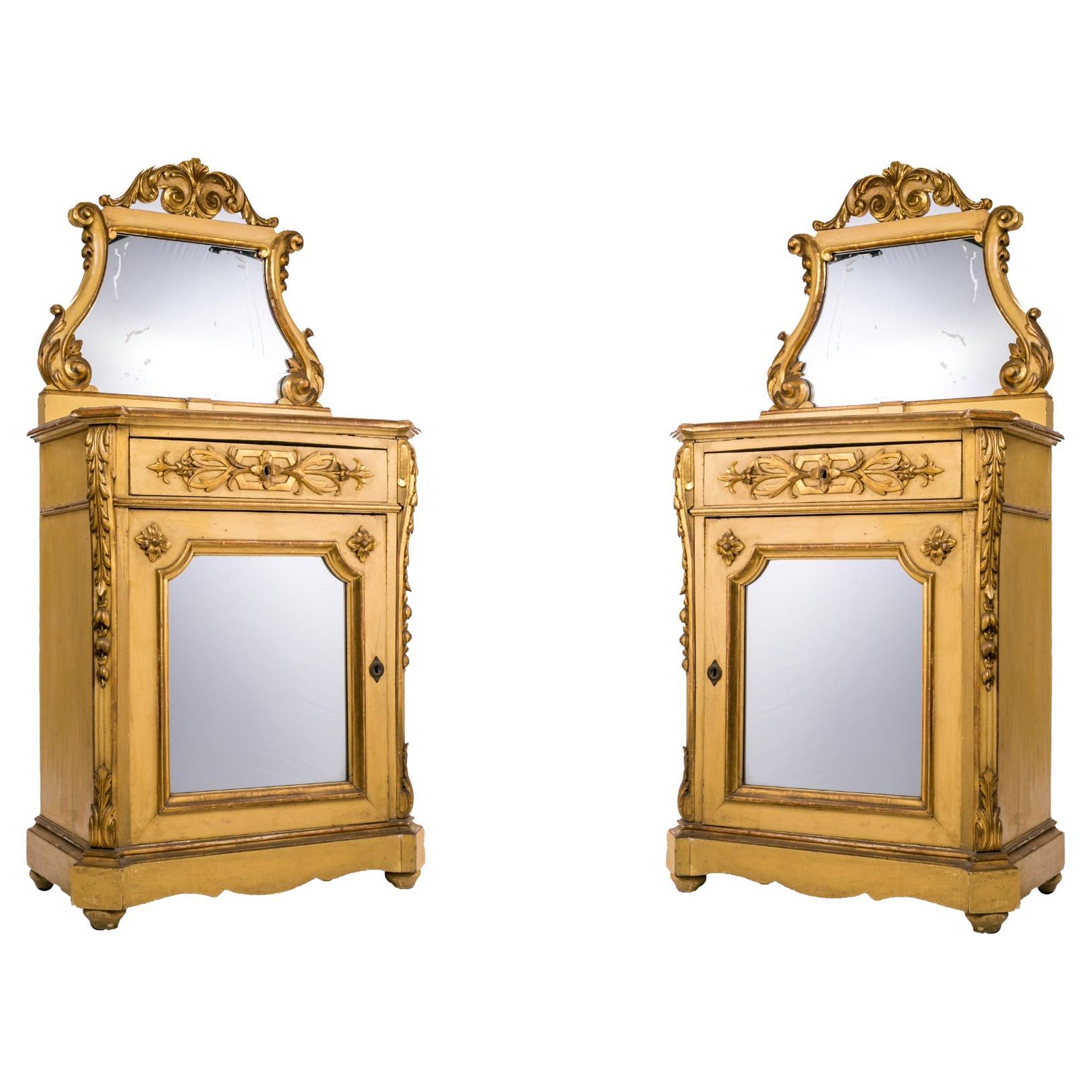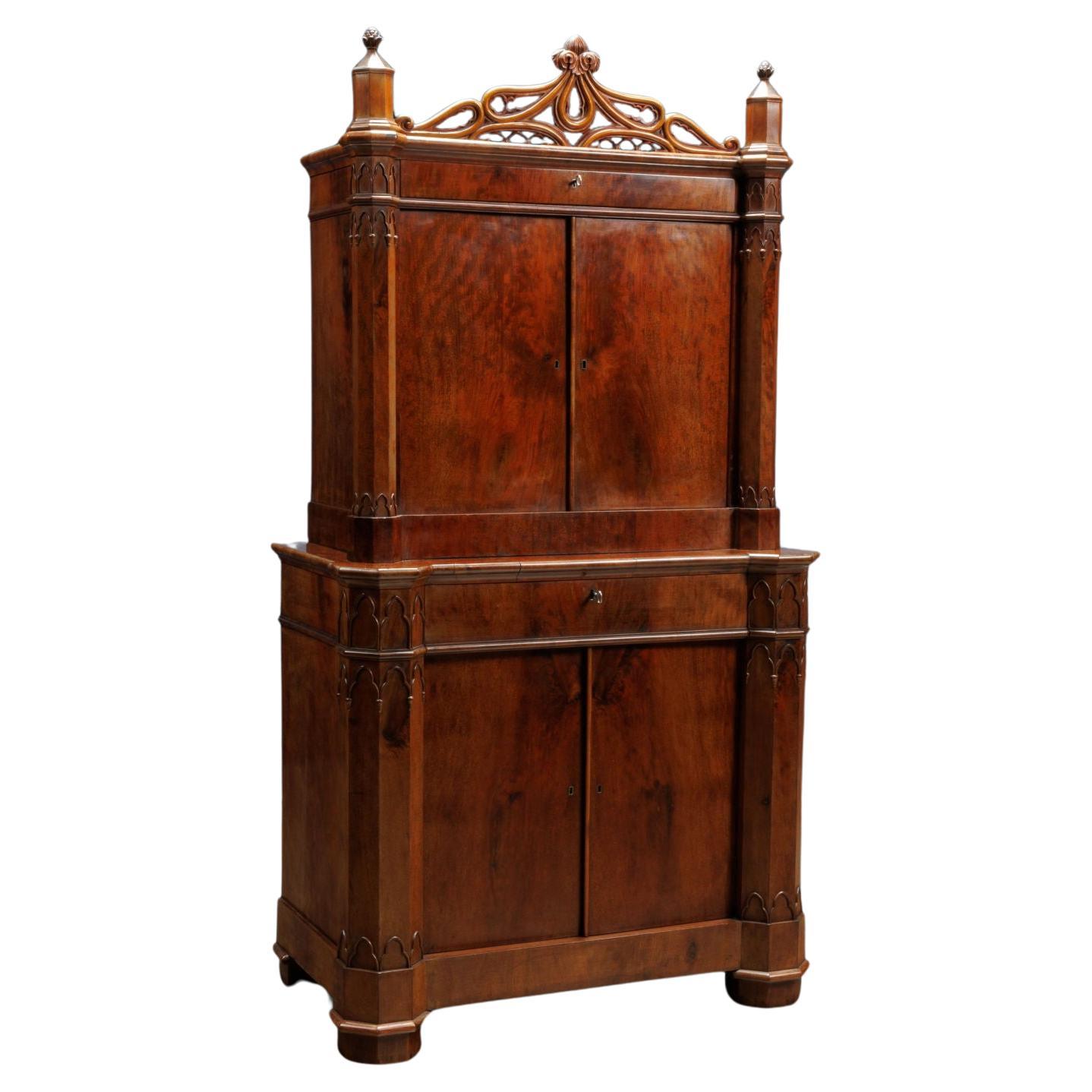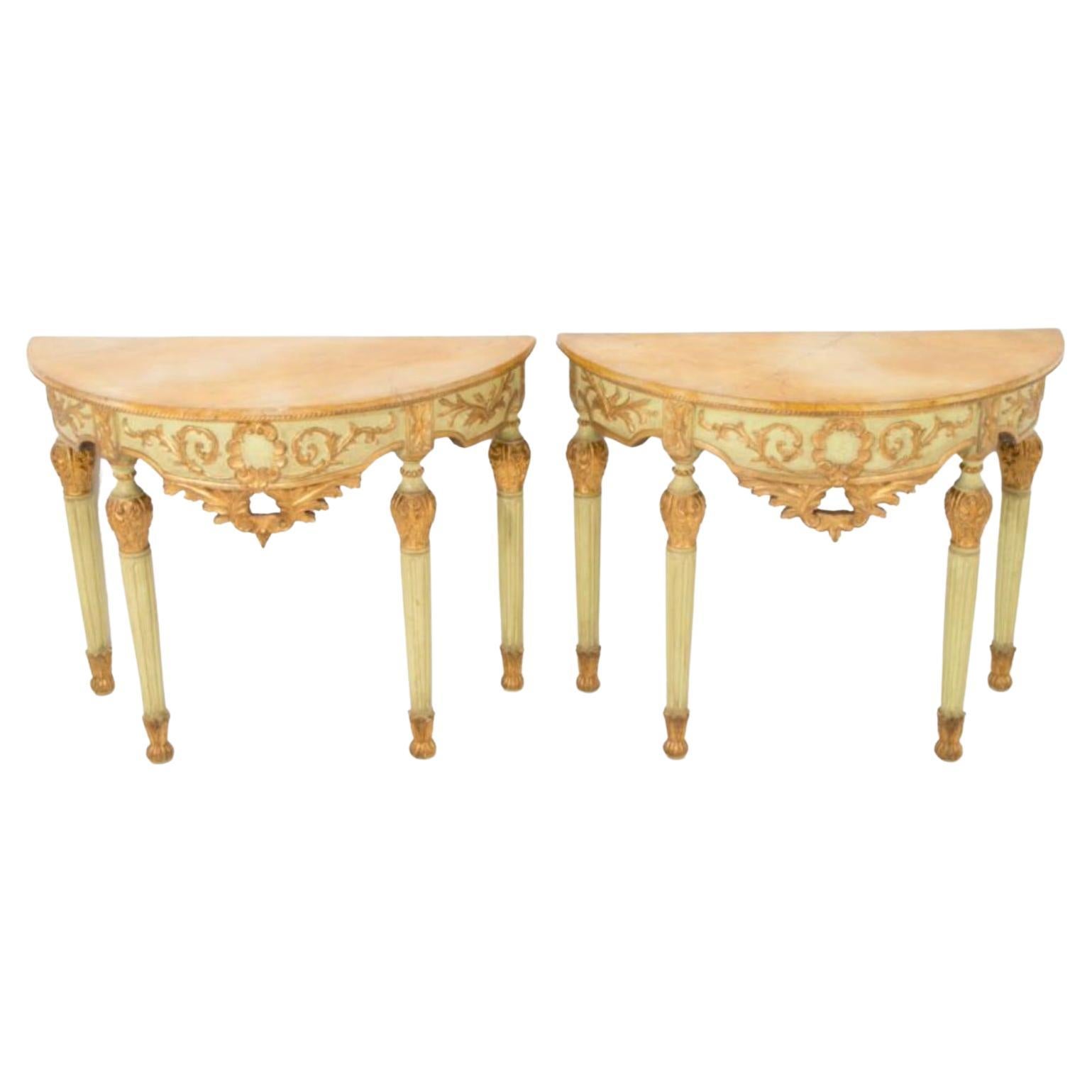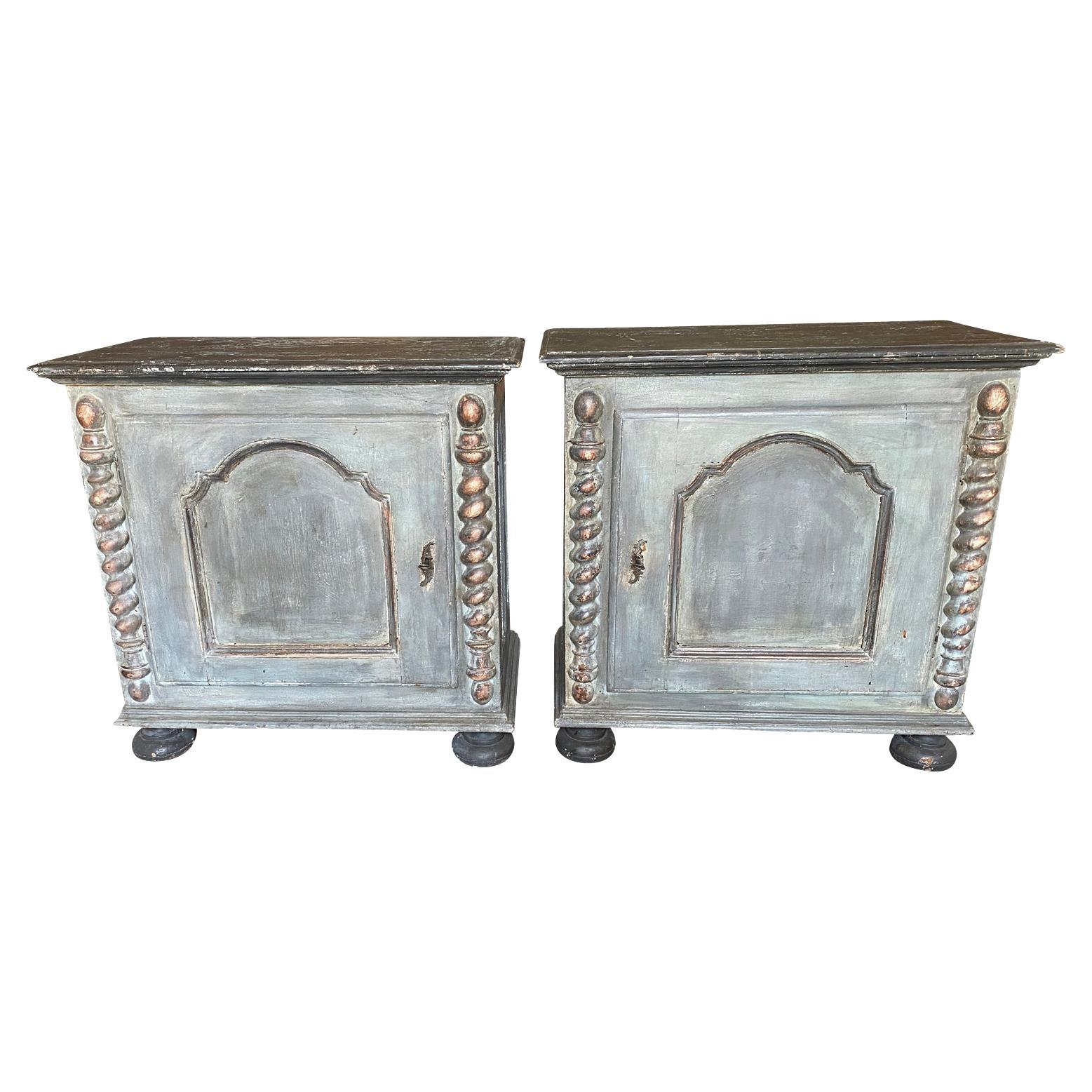Items Similar to Pair of sideboards Lucchese manufacture second decade of the 19th century
Want more images or videos?
Request additional images or videos from the seller
1 of 12
Pair of sideboards Lucchese manufacture second decade of the 19th century
About the Item
Pair of sideboards panelled in mahogany feather, resting on feet of which the front ones with a circular plinth, supporting uprights in the form of a lictor's fasces, terminating in leafy capitals. There is a pair of doors on the front to conceal three drawers, also veneered in mahogany feather; two additional drawers are concealed in the lower and undercounter fascias.
The meeting point between the two sashes is decorated with a symmetrical phytomorphic carving; floral and antemium carvings also adorn the under-shelf band, both on the front and the sides. The white Carrara marble top follows the contour of the cabinet, and the interior is chestnut and poplar.
While Lucca had been able to boast the status of an independent republic until 1799, that same year there was its fall and subsequent subjugation to the French. In 1805, at the explicit request of the city's senate, the Principality of Lucca and Piombino was sanctioned, the direction of which was entrusted directly by Napoleon Bonaparte to Felice Baciocchi, a Corsican general who a few years earlier had married its younger sister Elisa. She herself was given the honorary title of Grand Duchess of Tuscany and, in fact, it was she who ruled the territories directed by her husband.
Naturally, the influence of the French rulers was also reflected in artistic choices, drawing workers directly from Paris and commissioning local workshops to create works and furnishings that echoed transalpine taste. Contrary to the profound political change initiated during the Restoration period, which had sought to restore the pre-Revolutionary situation with the Congress of Vienna, the fashion for French furniture in the wake of what had been the Empire style continued in the following years. This mode was also found in Lucca itself, where Maria Luisa of Bourbon was established, who in the work of modernizing the Ducal Palace, directed by architect Lorenzo Nottolini, had furniture made faithful to this taste.
Such is the case with our pair of sideboards, overtly French in architectural and ornamental taste, but more homegrown in the choice of materials used. While the mahogany used for the veneer was a favorite wood in France, a different argument must be made for the woods used in making the frame. This is in fact not oak, which is more common in French-made furniture, but chestnut, a local wood widely used in making the structural part of furniture in central Italy. Similar discussion for poplar, which is found in the construction of the hull sides of our commodes, also frequently used in Tuscan furniture.
As mentioned earlier, the phytomorphic carvings and architectural layout also hark back to French taste: the circular plinth front feet, the drawer in the lower band as well as the two doors concealing the inner drawer unit are modes of execution that were widely used in France at the time. The idea of uprights in the shape of fasces lictorius also comes from this type of taste, with several examples in numerous pieces of furniture.
Among the most fitting comparisons in our case are some of the furnishings signed Jean-Jacques Werner, a Swiss cabinetmaker but active in Paris: the commode that came from the Governor's apartment at the Invalides and is now at the Musée des Artes Décoratifs, or the commode-secrétaire from the Grand Trianon dated 1819. The former is in fact characterized by the uprights in the shape of fasces lictors, while the latter features phytomorphic racemes on the front doors, making interesting comparisons possible even though those on the Versailles cabinet, as well as the rest of the decoration, are in gilded bronze and not carved wood as in our case. This last peculiarity of the furniture under consideration further allows us to approximate its production to a manufacture of Italian scope, where the availability of bronzes of fine workmanship was certainly more difficult, if not by importing them directly from France; on the other hand, the high quality of the cabinetry reminds us of skilled artists who entertained a close relationship with the transalpine country, if not the origin itself. It is no coincidence, perhaps, that in Lucca in those years the main workshop active for the Baciocchi first and for the Bourbon later was that of the Youf brothers, in whose production we find similar characteristics to those set out above for the pair of sideboards: they declare, in fact, their being French cabinetmakers in the taste and structure of the furnishings, while showing themselves to be open to Italian influences in the use of materials.
- Dimensions:Height: 40.16 in (102 cm)Width: 55.32 in (140.5 cm)Depth: 27.17 in (69 cm)
- Sold As:Set of 2
- Style:Restauration (Of the Period)
- Materials and Techniques:
- Place of Origin:
- Period:
- Date of Manufacture:1800s
- Condition:Wear consistent with age and use.
- Seller Location:Milano, IT
- Reference Number:1stDibs: LU1721239132452
About the Seller
4.9
Gold Seller
These expertly vetted sellers are highly rated and consistently exceed customer expectations.
Established in 2015
1stDibs seller since 2015
357 sales on 1stDibs
Typical response time: 1 hour
- ShippingRetrieving quote...Ships From: Milan, Italy
- Return PolicyA return for this item may be initiated within 10 days of delivery.
More From This SellerView All
- Pair of Candelabra Paris second quarter of the 19th centuryBy Non-Standard Furniture and LightingLocated in Milano, ITPair of partially gilded and burnished bronze candelabra. Stepped base from which departs the turned and chiseled body with leaf and antemium motifs, at the top of which is placed a ...Category
Antique 1850s French Restauration Candlesticks
MaterialsBronze
- Pair of Moors. Venice, Second half of the 19th centuryBy Non-Standard Furniture and LightingLocated in Milano, ITPair of torch-holding sculptures depicting two Venetian Moors, one female figure and the other male. In a mirrored position of slight advancement, they hold a tray in one hand while ...Category
Antique Mid-19th Century Italian Baroque Revival Figurative Sculptures
MaterialsWood
- Coin cabinet, Piedmont, second quarter of the 19th centuryBy Non-Standard Furniture and LightingLocated in Milano, ITTwo-body cabinet completely veneered in mahogany feather; it has both in the narrower upper part and in the lower part two doors surmounted by a drawer and framed by a pair of uprigh...Category
Antique 19th Century Other Sideboards
MaterialsMahogany
- Chinoiserie-style screen. Italy, second quarter 19th centuryBy Non-Standard Furniture and LightingLocated in Milano, ITFive-panel jointed screen; made of poplar entirely lacquered in black, it is decorated with Chinoise-like painted motifs: dragons, monkeys, birds, and reserves depicting scenes of Ch...Category
Antique 19th Century Italian Other Screens and Room Dividers
MaterialsPoplar
- Consolle. Tuscany, second quarter of the 18th centuryBy Non-Standard Furniture and LightingLocated in Milano, ITCarved and gilded wooden console table. It rests on four opposing double-curved supports ending in full-bodied curling volutes held by masks; carved female caryatids rest on the uppe...Category
Antique 18th Century Italian Other Console Tables
MaterialsGiltwood
- Mirror. Tuscany, second quarter of the 18th centuryBy Non-Standard Furniture and LightingLocated in Milano, ITCarved and gilded wooden mirror. The rectangular frame enclosing the mirror is carved with small scroll motifs on the corners with the bottom tapped with a burin. Surrounding the fra...Category
Antique Mid-18th Century Italian Other Wall Mirrors
MaterialsWood
You May Also Like
- 19th Century French Second Empire Period Marble Top BuffetLocated in Dallas, TX19th Century French Second Empire Period marble top buffet is a timeless example of the magnificent furnishings that emanated from France during t...Category
Antique 1870s French Napoleon III Buffets
MaterialsMarble, Bronze
- Pair of elegant lacquered cabinets from the mid-19th centuryLocated in Cesena, FCPair of elegant lacquered, gilded and carved cabinets. In perfect condition, they have never undergone restorations. Period: mid-1800s Measurements: width 80 cm; depth 45 cm; cabinet...Category
Antique Mid-19th Century Italian Credenzas
MaterialsMirror, Wood, Lacquer
- Pair of 19th Century Italian Console TablesBy Europa AntiquesLocated in Madrid, ESPair of 19th century Italian console tables 90x117x55cm Half-moon console in carved, lacquered and gilded wood. Good condition f...Category
Antique 19th Century Italian Baroque Credenzas
MaterialsWood
- PAIR OF ROMANTIC PORTUGUESE CONSOLES 19th CenturyBy Europa AntiquesLocated in Madrid, ESPAIR OF ROMANTIC PORTUGUESE CONSOLES 19th Century in mahogany wood, with carvings. Marble tops. Some little defects. Dim.: 86 x 97 x 50 cm good conditionCategory
Antique 19th Century Portuguese British Colonial Credenzas
MaterialsMahogany
- Pair of Mid-19th Century Italian BuffetsLocated in Atlanta, GAA delightful pair of mid-19th century buffets from the Genoa region of Italy. Wonderfully constructed from painted wood with a single door raised on bun feet.Category
Antique Mid-19th Century Italian Buffets
MaterialsWood
- 20th Century Pair of Lacquered Wood Italian Sideboards with Mirror, 1950Located in Vicoforte, PiedmontPair of sideboards with shelf, Italy, mid-20th century. Furniture rounded on the front and straight on the sides, in carved and lacquered wood, o...Category
Vintage 1950s Italian Credenzas
MaterialsWood
Recently Viewed
View AllMore Ways To Browse
Advent Of Time Clocks
Akaari Magistretti
American Fiddle Back Chair
Antique Crib Small Quilts
Antique Dhurrie Blue Rust
Antique Dudouyt Table
Antique Italian Baroque Bed Venetian Style
Antique North Wind Carved Side Chairs
Apparatus Table Lamp
Baccarat Sconce Pink
Bead Encrusted Italian Maria Theresa Beaded
Beata Heuman Style
Bed Reading Lamp Art Deco
Bellagio Bar Stool
Ben Seibel Vase
Black Leather Cesca Chair
Black Tokyo Stool By Rodney Kinsman
Blue Ceramic Marshal Studios Table Lamp
